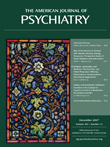Drs. Carr and Shrewsbury Reply
To The Editor: We appreciate the interest of Bobeck Modjtahedi, B.S., and Glen L. Xiong, M.D., in our clinical case conference recently published in the Journal . They propose that increased free valproic acid might lead to hyperammonemia and encephalopathy, even with a normal total valproic acid level. This assertion might indicate an important contributing factor to these adverse effects. However, their letter seems to equate free fraction with concentration. They focus on the well-known variability of valproic acid free fraction at higher total drug concentrations and seem to assert that the concentration of free valproic acid also increases exponentially at higher total drug concentrations. The U.S. prescribing information already establishes that protein binding of valproic acid at therapeutic levels is concentration-dependent, and the free fraction varies from “10% at 40 mcg/ml to 18.5% at 130 mcg/ml” (1) . In an excellent clinical case conference published in the November 2006 issue of the Journal(2) , Neil B. Sandson, M.D., et al. asserted that additional factors must be present in order to raise free valproic acid concentration when the free fraction changes. If either drug-drug competition or hypoalbuminemia limits the protein binding of valproic acid but nothing inhibits its metabolism or clearance, then “the free fraction of valproate increases and the total concentration of valproate decreases, but the free concentration of valproate does not change” ( 2 , p. 1894). In contrast, aspirin is an example of a medication that raises free valproic acid concentration when it both displaces valproic acid from protein binding sites and inhibits its metabolism. Mr. Modjtahedi and Dr. Xiong also do not mention this latter effect when stating that reports have shown that aspirin raises free valproic acid concentration.
Elevated free valproic acid concentration might be a potential risk factor for hyperammonemia. However, it might also develop after beta-oxidation shutdown. In our case conference, we reviewed the most likely mechanism behind valproic acid leading to hyperammonemia that has been described in the literature: the metabolism of valproic acid depletes hepatic carnitine resources, leading to the shutdown of both fatty acid beta-oxidation and the urea cycle. The reduction in available carnitine might then lead to the build up of valproic acid and ammonia simultaneously. However, future studies can help elucidate the risk factors and sequence of events underlying this complex adverse effect.
We agree that excessive free valproic acid concentration might contribute to encephalopathy. The mechanisms through which valproic acid produces encephalopathy are incompletely understood. Hyperammonemia is thought to play a major role, but according to Verrotti et al. (3) , there have been cases of encephalopathy with normal ammonia levels. Thus, there may be other unknown factors, such as potential neurotoxity from excessive unbound valproic acid. Exactly how excessive free valproic acid might have direct neurotoxic effects warrants further investigation.
Mr. Modjtahedi and Dr. Xiong advise monitoring free valproic acid concentration in the setting of hypoalbumenia and polypharmacy. Sandson et al. made similar recommendations (3) . We agree that this test should be considered. In our reported case, we did not measure the free fraction or free valproic acid level, and neither did any of the cases we reviewed in the psychiatric literature (1) . Unfortunately, the current expense of free valproic acid measurements limits its use to only specific circumstances, such as when toxicity is suspected and the total valproic acid concentration is normal or no other cause is found.
1. Depakote (divalproex sodium): http://www.rxabbott.com/pdf/depakote.pdfGoogle Scholar
2. Sandson NB, Marcucci C, Bourke DL, Smith-Lamacchia R: An interaction between aspirin and valproate: the relevance of plasma protein displacement drug-drug interactions. Am J Psychiatry 2006; 163:1891–1896Google Scholar
3. Verrotti A, Trotta D, Morgese G, Chiarelli F: Valproate-induced hyperammonemic encephalopathy. Metab Brain Dis 2002; 17:367–373Google Scholar



